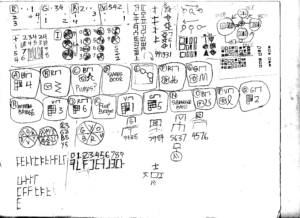Rhem: The Rest
 My previous Rhem sessions, taken all together, cover a minority of the game. I have just completed the rest in a single marathon session. People who do cryptograms are familiar with the moment when the code “breaks” and suddenly you’re discovering new leads faster than you can follow up on them. Rhem and other nonlinear puzzle-based adventure games have a similar tipping point. Not entirely for the same reason: here, it’s more do do with eliminating clues than finding new ones. But both forms share the property that the more you understand, the easier it is to understand more.
My previous Rhem sessions, taken all together, cover a minority of the game. I have just completed the rest in a single marathon session. People who do cryptograms are familiar with the moment when the code “breaks” and suddenly you’re discovering new leads faster than you can follow up on them. Rhem and other nonlinear puzzle-based adventure games have a similar tipping point. Not entirely for the same reason: here, it’s more do do with eliminating clues than finding new ones. But both forms share the property that the more you understand, the easier it is to understand more.
The chief reason for this in adventure games is that the more you see of a game, the better you understand how the author thinks. There are a few basic organizing principles in Rhem that, once grasped, make the whole game easier to think about. One is the overall structure of the map: there’s a large central area, with various drawbridges and rotating platforms and the like to make it difficult to get around, and there are various mostly-self-contained peripheral areas hanging off of it. The fact that the peripheral areas aren’t entirely self-contained, coupled with the lack of an obvious boundary between them and the central area, obscures this structure. But recognizing it is useful, not just for navigation, but because it lets you make certain assumptions — for example, that actions performed in the central area won’t affect things in the periphery. This assumption isn’t always true, but whenever there’s an exception, there’s some kind of clue indicating it.
Another very big part of the author’s style is heavy use of the close-the-door-behind-you puzzle. This is one of the basic puzzles of the Myst-like genre, because it’s one of the few puzzles, other than combination-lock variants, that you can do with a one-click interface and no inventory. 1 Rhem actually has a certain amount of inventory, but it’s only used in the endgame. Here’s how it goes: A room is initially reached through a door that can be only opened and closed from the outside (typically because it’s button-operated). The contents of the room directly or indirectly grant access to an alternate route into that room. The trick is that closing the door alters the room in some desirable way — maybe there’s something written on the back of the door, maybe there’s a passageway that’s concealed by the door when it’s open, whatever. So you have to close the door from the outside, which players won’t normally do, and enter through the alternate route. Understand that I mean these words in an abstract and general way: the “room” can be a hallway or even outdoors, as long as access to it is limited, and the the “door” might be a ladder or a drawbridge or something, as long as it has two positions, one passable and one impassible, and no immediately obvious reason to return it to the impassible position. I think every single game in the Myst series uses this puzzle at some point, but Rhem really exploits it for all it’s worth, dressing it up in all kinds of guises and daisy-chaining instances of it in loops where one room’s door is another room’s alternate route. After my first session, I wrote that the game’s layout was hard to grasp, even with a map. By the end, I had pretty much internalized it, due to repeatedly running through that central area in order to get to the other side of closed doors.
In the course of solving this game, in addition to the notations on my map, I covered most of one side of a standard sheet of paper with notes that will be incomprehensible to me in a month or two. Zarf’s review mentions taking six pages of notes, which I suppose shows different habits: his notes may be more verbose, and he probably wrote things down that I didn’t. In cases where I discovered information and already knew where it was to be used, I often just temporarily committed it to memory. Consequently, the bulk of my notes were taken in the beginning, when I didn’t yet understand anything. But also, in many cases I circumvented note-taking by taking screenshots. This isn’t something I often do in adventure games, but Rhem pretty much asked for it: several points showed complicated screenfulls of data that I didn’t yet know how to filter into something simple to copy down. And, being old and written in Macromedia Director, the game switches to the background quickly and without hassle, making it easy to switch to an image viewer whenever I wanted to check on stuff. My map is based around two screenshots of partial maps found in the game, assembled in an image editor and printed out so I could write on it.
Anyway, I have to agree with what pretty much every review of Rhem says: it’s great stuff, if you like this sort of thing. It’s all a big complicated system made of rusty piping and cinderblocks, and the joy of the game is in coming to understand that system.
| ↑1 | Rhem actually has a certain amount of inventory, but it’s only used in the endgame. |
|---|
 Comments(0)
Comments(0)